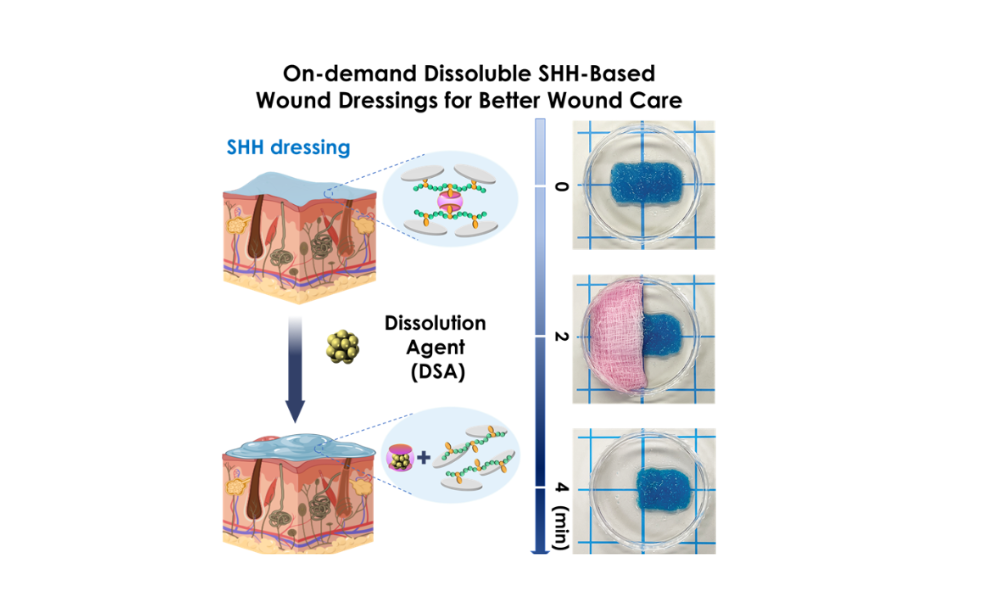Press ReleaseSep | 26 | 2022
A Hydrogel That Allows for Quick Burn Dressing Changes While Minimizing Pain Has Been Developed by Mass General


Key Takeaways
- Bioengineers have developed a first-of-its-kind hydrogel for second-degree burns that can be dissolved quickly and easily for wound dressing changes using a solution that breaks apart the supramolecular structure of the hydrogel
- The new biomaterial would help eliminate painful wound dressing changes for patients that increase the risk of wound infections and potentially life-threatening sepsis and multi-organ failure
- The material is based on an environmentally friendly, non-toxic approach to hydrogel preparation
BOSTON – An advanced hydrogel that promotes wound healing for second-degree burns and can be dissolved quickly and easily during dressing changes while minimizing pain and trauma for patients has been developed by bioengineers at Massachusetts General Hospital (MGH).
The state-of-the-art biomaterial, described in the journal Bioactive Materials, is highly absorbent and based on "green" chemistry approaches that eliminate many toxic and reactive chemicals used in traditional wound dressings.
"Current dressings adhere to the wound and need to be surgically or mechanically debrided, resulting in delayed healing and traumatization of newly formed tissue, not to mention excruciating pain for the patient," says O. Berk Usta, PhD, with the Center for Engineering in Medicine and Surgery at MGH.
"In collaboration with Tufts University, our team set out to create a supramolecular hydrogel that could be dissolved on demand for trauma-free and quick removal by the physician, thus reducing the need for analgesics and opioids as well as for hospital stays and costs."
Hydrogels are placed directly on the wound and covered by secondary gauze or protective dressings. They consist of a network of synthetic polymers cross-linked into a mesh structure that is designed to retain water and create a moist environment to accelerate wound healing.
What makes the MGH/Tufts biomaterial unique is a combination of factors, including the fact that it is dissoluble in less than five minutes for easy patient care using a solution that breaks apart the supramolecular structure of the hydrogel without any adverse effects on skin cells.
In addition, the protective wound barrier can be assembled in around 15 seconds versus the lengthy and potentially hazardous methods of current hydrogel preparation, which may also be harmful to the environment due to their use and generation of toxic chemicals.
And because the hydrogel is hybrid, it combines the mechanical, or elastic, properties comparable to those of a solid with the diffusive properties of a liquid for moist wound propagation.
"Hydrogel dressings for timely and healthy burn wound healing have been around for years, but they are far from ideal and represent an area of intense investigation by scientists and bioengineers," explains A. Aslihan Gokaltun, PhD, an instructor in surgery at MGH and Harvard Medical School, and first author of the study. "We successfully created a supramolecular hybrid hydrogel to eliminate painful wound dressing changes that may increase the risk of wound infections, leading to life-threatening sepsis and multi-organ failure."
Another advantage of this first-of-its-kind burn dressing is its anticipated easy adaptability to the consumer market.
"The simple and rapid method we developed to synthesize and assemble the hydrogel components will allow for large-scale production and low-cost commercialization," explains co-author Ayse Asatekin, PhD, with Tufts University.
"And that will pave the way for translating this breakthrough science into a viable therapeutic application in a field where there is still no recognized standard of care."
Usta is an associate professor of surgery at the Center for Engineering in Medicine and Surgery at MGH and an associate professor of surgery at Harvard Medical School (HMS). Asatekin is an associate professor in the Department of Chemical and Biological Engineering at Tufts University.
The study was partly funded by the National Institutes of Health, the National Science Foundation and Shriners Hospitals.
About the Massachusetts General Hospital
Massachusetts General Hospital, founded in 1811, is the original and largest teaching hospital of Harvard Medical School. The Mass General Research Institute conducts the largest hospital-based research program in the nation, with annual research operations of more than $1 billion, and comprises more than 9,500 researchers working across more than 30 institutes, centers, and departments. In July 2022, Mass General was named #8 in the U.S. News & World Report list of "America's Best Hospitals." MGH is a founding member of the Mass General Brigham healthcare system.
Type
Centers and Departments
Topics
Check out the Mass General Research Institute blog
Bench Press highlights the groundbreaking research and boundary-pushing scientists working to improve human health and fight disease.
Support Research at Mass General
Your gift helps fund groundbreaking research aimed at understanding, treating and preventing human disease.
